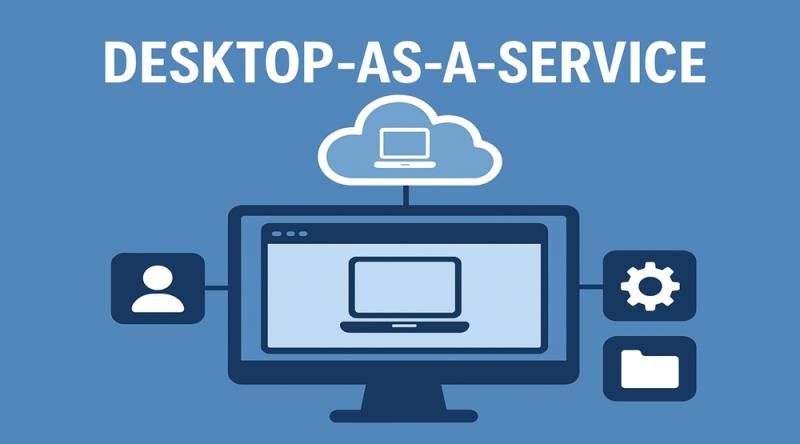Desktop-as-a-Service (DaaS) Market: Competitive Landscape, Key Players & Investment Insights
In the rapidly evolving cloud-computing landscape, the Desktop-as-a-Service (DaaS) model has emerged as a key pillar of modern end-user computing strategy. For organizations tackling remote and hybrid workforce models, DaaS offers a virtual desktop environment delivered from the cloud, enabling anytime, anywhere access and offloading much of the management burden onto the service provider. As enterprises increasingly demand agility, security, cost-predictability and scalability in their workspace environments, DaaS becomes a strategic lever rather than just a cost-saving exercise. The following analysis covers leading companies in the DaaS space, evaluates their competitive strengths, then presents a combined SWOT framework and finally examines investment opportunities and broader trends.
Explore detailed profiles of top players and new entrants in this space – access your free sample report → https://www.researchnester.com/sample-request-4123
Top Companies & Their Strategies
Here’s a strategic profile of six major or emerging players driving the DaaS market.
Microsoft Corporation – Azure Virtual Desktop / Windows 365
Microsoft’s effort in the DaaS space revolves around its Azure Virtual Desktop (AVD) platform and Windows 365 Cloud PC offerings. The strength lies in deep integration with Microsoft 365, Azure infrastructure and enterprise identity and security ecosystems. According to Microsoft, AVD is foundational to many organizations’ cloud-adoption strategy. Microsoft also emphasises multi-session Windows 11, hybrid deployments via Azure Stack HCI and robust compliance credentials. For enterprises already embedded in the Microsoft stack, this makes DaaS adoption smoother and more strategic rather than standalone.
Amazon Web Services, Inc. (AWS) – Amazon WorkSpaces / WorkSpaces Core
AWS brings its hyperscale cloud infrastructure to the DaaS opportunity via Amazon WorkSpaces and WorkSpaces Core. The company has been recognised as a “Leader” in Gartner’s 2025 Magic Quadrant for DaaS. Its global footprint, mature cloud operations, strong automation and support ecosystem enable enterprises to deliver virtual desktops at scale. For businesses already on AWS, WorkSpaces offers an integrated path to DaaS deployment. Recent announcements-such as the availability of Citrix DaaS Machine Creation Services on WorkSpaces Core-demonstrate growing ecosystem support.
Citrix Systems, Inc. – Citrix DaaS
Citrix is a long-standing player in desktop and application virtualization, with its DaaS offering designed to span Windows and Linux desktops across public cloud, hybrid or on-premises environments. Citrix’s value lies in its HDX protocol for high-performance user experience, broad endpoint support, and hybrid cloud flexibility. In complex, enterprise-grade scenarios with heterogeneous infrastructures and high demands for performance or customization, Citrix remains a key contender.
Get deeper insights into competitive positioning and strategic benchmarking: Download our sample Fitness Equipment Market report here → https://www.researchnester.com/sample-request-4123
VMware, Inc. – Horizon Cloud
VMware’s Horizon Cloud service targets customers who want to deliver virtual desktops and apps across multiple clouds (Azure, IBM, private cloud) with unified management. The advantage here is VMware’s long heritage in virtualization and enterprise deployment, offering a consistent user-experience and migration path from traditional VDI to DaaS.
Nutanix, Inc. – Frame / Nutanix DaaS
Nutanix has extended beyond its hyper-converged infrastructure base into the DaaS space. Its “Frame” technology allows Windows and Linux desktops to run in multiple clouds or on-premises-providing flexibility in deployment models. This emerging positioning gives Nutanix the opportunity to address niche markets (e.g., GPU-accelerated workloads, edge/remote sites) with cross-cloud support.
Nerdio, Inc. – Virtual Desktop Enablement & SMB Focus
While not purely a DaaS provider in the same league as the hyperscalers, Nerdio offers solutions that make DaaS (especially on Azure or Windows 365) easier and more cost-effective, particularly for SMEs and MSPs. From its own disclosures it raised significant funding to support its virtual desktop management platform. Nerdio’s positioning is complementary: helping organisations unlock the full potential of DaaS with management, cost-optimisation and automation.
These six companies reflect a spectrum of DaaS strategies: hyperscaler-led (Microsoft, AWS), specialist virtualization (Citrix, VMware), emerging flexible providers (Nutanix) and management-layer enablers (Nerdio).
Interested in a customized SWOT for your target competitor? Request your tailored assessment → https://www.researchnester.com/reports/desktop-as-a-service-daas-market/4123
SWOT Analysis (For Leading DaaS Providers as a Group)
Here’s a combined SWOT analysis reflecting the collective strengths, weaknesses, opportunities and threats of the leading DaaS companies.
Strengths
• The leading DaaS providers benefit from massive cloud infrastructure scale, global data-centre footprints and enterprise-grade security, which provide a strong foundation for delivering virtual desktops at scale.
• Deep ecosystem integration (for example Microsoft’s synergy with Azure/365, AWS’s cloud services) enables broader value beyond simply virtual desktops, such as identity, collaboration, device management and analytics.
• Pay-as-you-go consumption and simplified lifecycle management make DaaS a compelling alternative to traditional on-premises desktop infrastructure-especially in remote/hybrid workforce scenarios.
• Rich feature sets such as multi-session Windows environments, GPU-enabled desktops, global brokerage management, and cross-cloud deployment give providers the flexibility to serve diverse user-types from knowledge workers to power-users.
Weaknesses
• Many organisations still face steep costs or complexity in migrating legacy desktop workloads to DaaS; the management of virtual desktops, image control, user-experience, licensing and cost-governance remains non-trivial.
• Vendor lock-in is a concern: organisations deeply embed within a particular provider’s cloud/desktop stack may find switching costly or disruptive.
• Dependence on internet connectivity and cloud-latency can impact user experience (especially for graphics-intensive or real-time collaboration workloads), which constrains some use-cases.
• The desktop market is still more heterogeneous and complex than many SaaS or cloud infrastructure markets-end-user computing needs vary widely in apps, compliance, devices and user-types, which slows standardisation and complicates go-to-market.
Opportunities
• Broader adoption beyond remote-work scenarios: Recent analyst commentary indicates DaaS is shifting from being just a remote-work enabler to a broader cost-optimisation, sustainability and flexible-workforce tool.
• Growth in GPU-accelerated virtual workstations, hybrid/edge deployments, and industry-specific use-cases (e.g., healthcare, legal, engineering) offers niche white-space for innovation and higher-value services.
• Consolidation through M&A, partnerships and bundling (desktop + apps + security + device lifecycle services) can strengthen provider value propositions and lock in enterprise customers.
• Regional expansion (Asia-Pacific, Latin America, emerging markets) remains under-penetrated, giving DaaS providers geographic growth lanes and opportunity to scale localised offerings.
Threats
• Competitive intensity is high and escalating: Many legacy VDI vendors, cloud providers, MSPs and telecoms are positioning to capture DaaS workloads, which may pressure pricing and margins.
• Pricing transparency and cost management risks: Without careful governance, DaaS deployments can escalate in cost or fail to deliver expected savings, leading to scepticism in enterprise buying committees.
• Data-sovereignty, compliance and latency issues in regulated industries (e.g., finance, health, government) could slow migration and favour specialised/local providers over global hyperscalers.
• Technology disruption (e.g., shift to zero-trust desktops, mobile-first computation, edge-client execution models) could change the value-proposition of “desktop in the cloud” and require providers to adapt rapidly.
Access a complete SWOT breakdown with company-specific scorecards: Claim your sample report → https://www.researchnester.com/sample-request-4123
Investment Opportunities & Trends
From an investment perspective – whether investing in providers, partnering ecosystems or underlying technologies – several themes stand out in the DaaS market.
M&A Activity & Consolidation
The DaaS market is entering a phase of consolidation. Larger cloud/infrastructure providers are acquiring specialist desktop-virtualisation or workspace management tools to broaden their up-the-stack offerings. For instance, announced integrations such as Citrix DaaS on AWS’s WorkSpaces Core (July 2025) illustrate how vendors are partnering or consolidating to fill gaps. Investors should watch for further acquisitions of MSP-oriented DaaS enablers, workspace-management firms or GPU/graphics-workstation-as-a-service players.
Funding in Start-ups and Enablers
There’s a growing wave of activity in firms that provide management layers, automation tools or niche DaaS models (e.g., GPU workstations, vertical-specific desktops). Nerdio, for example, raised significant funding to enable virtual desktop deployment at scale for SMEs. Investing in these adjacent segments may offer higher growth potential (though also higher risk) compared to the major hyperscalers.
Technology Integration & Workspace Innovation
Beyond simply “desktops in the cloud,” investors should look at technological enhancements: autoscaling and AI-driven cost optimisation, multi-session Windows environments, embedded collaboration (Teams, Zoom optimisation), GPU/workstation delivery, hybrid/edge desktop models, and zero-trust architecture. The 2025 Gartner commentary noted DaaS is being deployed for cost, operational and sustainability reasons-not just remote work. Investments in these innovation vectors may offer differentiated returns.
Regional Expansion & Underserved Markets
Although DaaS is mature in North America and Western Europe, there remain underserved geographies (Asia-Pacific, Latin America, parts of MEA) where remote/hybrid work transitions are accelerating. Regional players or global providers with meaningful local footprint can capture substantial share. For investors, funds targeting regional DaaS service deployers, cross-cloud brokers or data-centre operators in emerging markets present interesting exposure.
Recent Notable Developments (Last 12 months)
• AWS was formally recognised as a Leader in the 2025 Gartner Magic Quadrant for Desktop as a Service.
• Microsoft likewise was recognised in the 2024 (and continuing) Gartner Leader category for its DaaS offerings and emphasised new feature-investments (e.g., enhanced GPU support, hybrid on-premises deployment via Azure Stack HCI).
• Citrix and AWS launched the general availability of Citrix DaaS Machine Creation Services on Amazon WorkSpaces Core in July 2025 – signalling growing ecosystem convergence.
• Analysts are highlighting that DaaS adoption is broadening beyond purely remote-work use-cases into cost-efficiency, sustainability and workforce flexibility mandates.
Get exclusive intelligence on M&A, funding pipelines and regional opportunities: Download your sample report → https://www.researchnester.com/sample-request-4123
Contact Data
AJ Daniel
Corporate Sales, USA
Research Nester
77 Water Street 8th Floor, New York, 10005
Email: info@researchnester.com
USA Phone: +1 646 586 9123
Europe Phone: +44 203 608 5919
About Research Nester
Research Nester is a one-stop service provider with a client base in more than 50 countries, leading in strategic market research and consulting with an unbiased and unparalleled approach towards helping global industrial players, conglomerates and executives for their future investment while avoiding forthcoming uncertainties. With an out-of-the-box mindset to produce statistical and analytical market research reports, we provide strategic consulting so that our clients can make wise business decisions with clarity while strategizing and planning for their forthcoming needs and succeed in achieving their future endeavors. We believe every business can expand to its new horizon, provided a right guidance at a right time is available through strategic minds.
This release was published on openPR.















